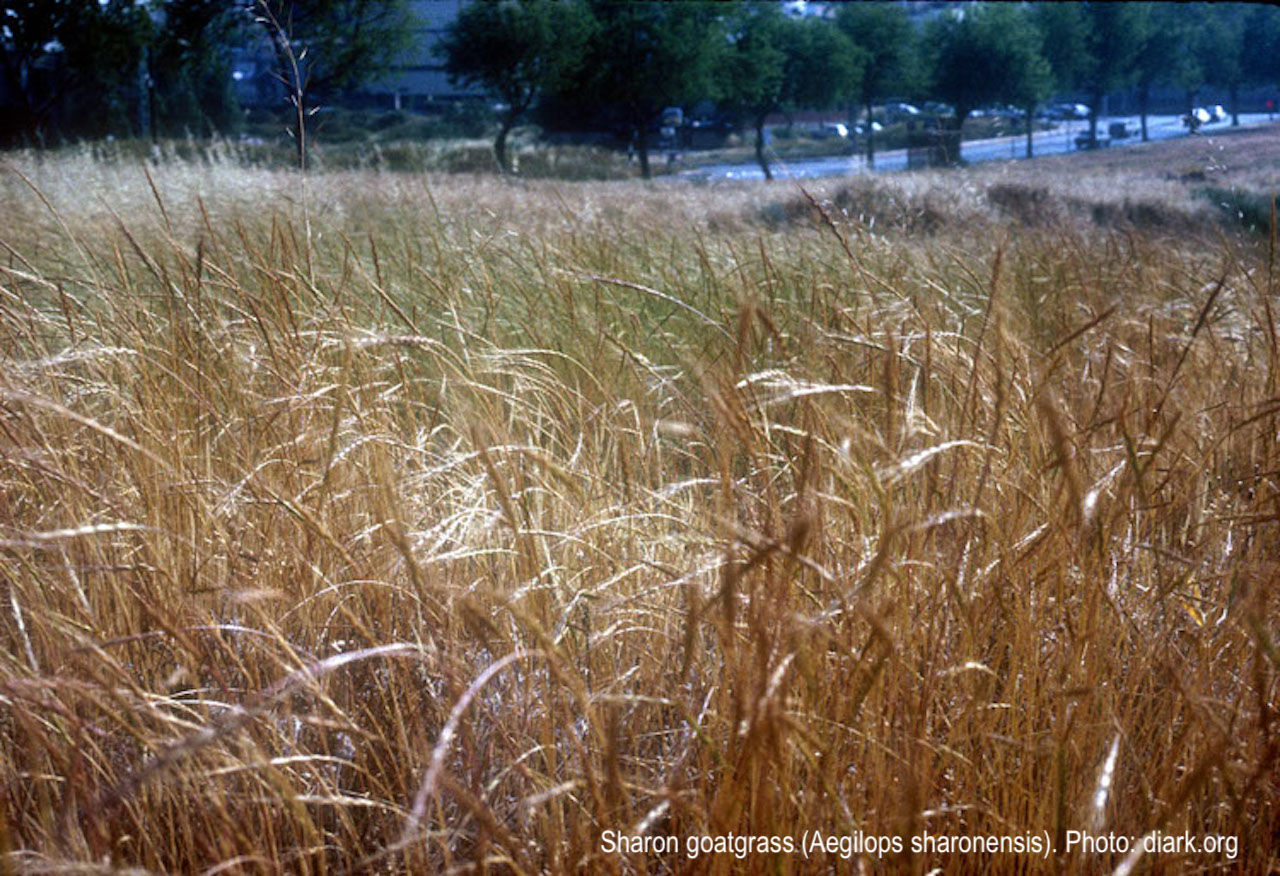A wild grass with excellent disease resistance genes may come to the aid of wheat, struggling under an onslaught of microbial enemies.
By Larry Hodgson
Wheat (Triticum spp.) is a staple grain all over the world. Some 35% of the world population depends on it. And it’s a fragile dependency. Wheat harvests can be affected by drought, rain, wind, frost, war, insects and, of course, diseases. In fact, disease epidemics are becoming more frequent due to climate warming. This allows microbes to expand to new territories.
Scientists are scrambling to find wild grasses with interesting disease resistance packages that could be incorporated into wheat. One such grass is Sharon goatgrass (Aegilops sharonensis), a wild annual grass from Israel and southern Lebanon.
Goatgrasses are genetically similar to wheat and cross with it in the wild. In fact, many modern wheat varieties have genes that came from wild goatgrasses. These are crosses that took naturally place over some 10,000 years of wheat culture.
Not Much to Look At
Sharon goatgrass itself is not unknown. In fact, its incredible resistance to wheat stem rust has long been noted. In fact, it’s highly resistant to many wheat diseases, including powdery mildew and leaf rust. But it’s a wild grass of otherwise little interest. It’s a small, wispy, short-lived grass with small grains of little value. As a result, it has gone under the radar of wheat breeders until recently.
Now that scientists are seriously studying it, though, another problem has come to the fore. It’s reluctant to cross-pollinate with wheat. Breeders can do it, but it takes time and perseverance. It would likely take decades of conventional hybridization to transfer the desired resistance from Sharon goat grass to a wheat by tradition crosses. But with modern genetic technology, scientists could accomplish that in only a few years.
Known Thine Enemy

The disease of greatest concern is wheat stem rust fungus (Puccinia graminis f. sp. tritici), the most prevalent of all the wheat rust diseases worldwide. It regularly causes serious outbreaks in North America, Europe, South America, and Asia, especially India, and is an ongoing problem in Australia.
Wheat stem rust is considered to reduce wheat production by some 21% globally, so a wheat rust resistant wheat would be of incalculable value. In fact, breeding for disease resistance in wheat is likely to prove as important for total wheat production as breeding for an increase in yield.
What Researchers Discovered
A collaborative international team of researchers led by the John Innes Centre, The Sainsbury Laboratory, and the University of Minnesota worked together, studied Sharon goatgrass, developing a genetic map of the species, then scanned it for mutations offering disease resistance against wheat stem rust. They used a search tool technique called Mutant Hunter in doing so. They found a gene, Sr62, that encodes a molecule called a tandem protein kinase and that does just that: it blocks the disease entirely. When transferred to different wheat varieties, it conferred strong protection against all tested strains of wheat stem rust.
Studies continue, looking at how this gene functions. It might even be possible to enhance its qualities through bioengineering.
One of the researchers, Dr. Brande Wulff, a researcher at King Abdullah University of Science and Technology (KAUST) and one of the authors of the studies, declared: “We now have this blockbuster gene that confers amazing immunity. If I were stem rust, I would be shaking in my spore.”
Genetic Engineering

The research team hopes to include the new gene into a stack of genes using genetic modification technology. They predict that they’’ll identify more diseases resistance genes in populations of Sharon goatgrass and other wild grasses. The researchers further say this could pave the way to breed genetically modified traits into wheat more widely in the face of the ongoing climate crisis.
The question then becomes whether people around the world are willing to accept genetically modified products. In some countries, opposition is likely to be fierce.
Further Reading
The hardy wild grass that could save our bread
Wheat, 1; Stem rust 0: blockbuster gene could be kryptonite for costly fungus
Aegilops sharonensis genome-assisted identification of stem rust resistance gene Sr62


Interesting article. Another sign that climate changes are affecting everything faster than we or Nature can adapt to without help. I do agree with the above comment re: who gets to control and distribute these newly developed seed strains. Large scale businesses don’t have the greatest track record in making sure everyone has access to them without mortgaging the farm.
Nice article but the last paragraph betrays an unsettling naiveté or deliberate bias which continues to surface in many modern arenas from racism to vaccine hesitancy ( note: not the same as politically motivated anti-mask – ism). What honest people fear is not necessarily the genetic modification itself but the motives of the elites who promote most of them. When those behind corporations which control access to foods and all other resources produce for profit with little to no regard for the well being of the planet and the people on it and show time and time again that they are in fact willing to ruthlessly sacrifice both (i. e. Monsanto’s desire for total control of a market leading to attempts to crush scientific studies, seed saving and heritage varieties, despite the fragility of monoculture, despite the effect of pesticides and herbicides on pollinators, etc etc ) in pursuit of profit, it is more about a sensible distrust of those who control the sale and distribution of GM products than about the idea of GM products themselves.